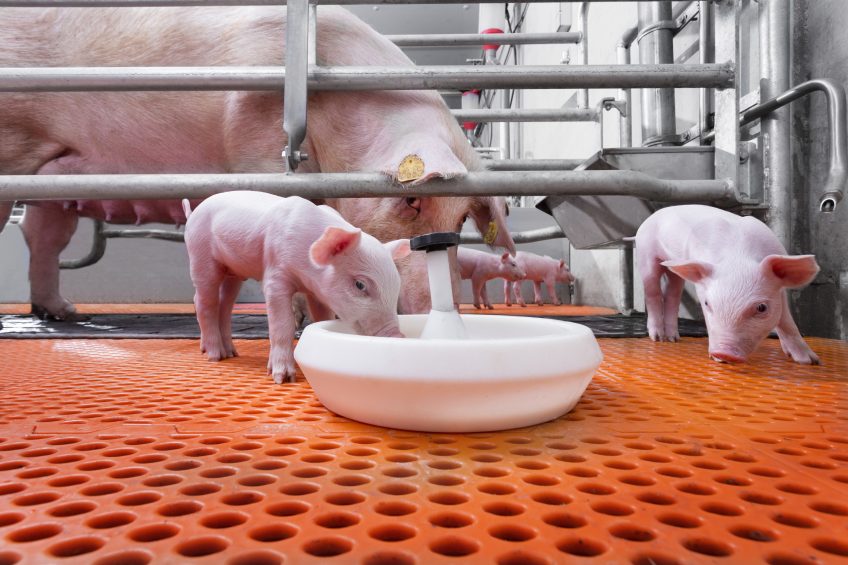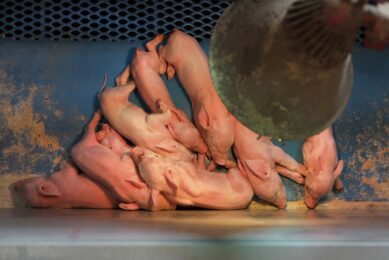Creep feeding helps nursery pigs thrive

Creep feed is traditionally offered to piglets in their first few weeks of life to allow them to get used to solid feed. It doesn’t have to stop there, however. Recent research indicates that with higher quality creep feed and subsequent weaner nutrition, pigs perform and feel better.
The increase in litter size over the past few years has resulted in a greater number of low-birth-weight piglets and the reduced availability of sow milk per piglet. Greater variability, inferior performance and slower barn throughput are among the more visible long-term consequences. As farmers start to recognise these challenges, the use of creep feeding for large litters has become increasingly popular.
Creep feeding does not always result in greater weaning weights, especially in early weaned pigs, but the main benefit comes from enhanced post-weaning feed intake and better development of the gastro-intestinal tract. Weaning is a period during which the pig can encounter stress. Early and high feed intake post-weaning and a well-prepared gastro-intestinal tract are crucial to increasing performance and improving the wellbeing of the nursery pig.
Effects of the use of creep feeding
At the Swine Research Centre (SRC), Trouw Nutrition has been conducting a number of research studies to evaluate the effects of the use of creep feeding in large litters. Results have shown that suckling piglets supplemented with Milkiwean Yoghurt had greater intake and weight gains post-weaning. The nursery batch was also more homogeneous. Additionally, piglets consuming the supplement had greater intestinal cell proliferation and better development of the small intestine than non-creep-fed piglets.
Concentrations of fermentation products in the large intestine were also greater in creep-fed piglets, indicating an active microbial population. These outcomes suggest that the weanling pig is better prepared to face the demands of the weaning process, is capable of better dietary nutrient uptake, and will also grow faster in the nursery.
To explain the effects of early-life nutrition strategies on nursery pig performance and metabolism, a research study was conducted at Trouw Nutrition’s SRC where piglets were fed 2 feeding programmes (Figure 1): a budget vs. high plane of nutrition, which included the yoghurt product range. Pigs were weaned at 24 days of age and blood samples were collected at 18 days post-weaning for metabolomics analysis.
- In the budget programme, no creep feed was offered and a weaner diet was formulated to deliver a similar nutrient load post-weaning, as in the other programme. However, expensive, highly digestible/palatable feed ingredients were omitted. The weaner diet was offered right after weaning up to day 18 post-weaning (42 days of age).
- The high quality programme was designed to deliver a high plane of nutrition using creep feed and a high quality weaner diet, both based on high quality feedstuffs and incorporating ingredients that support intestinal development. Specifically, the yoghurt strategy was offered from day 2 to 14 days of age, and 2 subsequent diets (Milkiwean Precoce and Granito) from day 15 up to 5 days post-weaning. The weaner diet (Milkiwean Spido) was offered from day 5 to day 18 post-weaning.
The main benefits of creep feeding and a high-quality weaner diet were observed in the nursery, where pigs on the high quality programme showed greater feed intake (26% greater) and feed efficiency (6% greater) resulting in greater body weights. The average daily gain of pigs fed the high quality diet from weaning up to day 18 post-weaning was greater than in pigs fed the budget programme (285 g/d vs. 211 g/d, respectively), and the body weight at 42 days was therefore higher in the pigs fed the high quality diets (12.0 kg vs. 10.1 kg).
Figure 1 – Feeding programmes offered.

Reducing weaning stress
To evaluate the effects of different feeding programmes on the metabolism of nursery pigs, blood samples were analysed for metabolomics. This involved analysing a broad array of nutrients and intermediates in an attempt to understand what is taking place in the metabolism of the pig. Results showed differences in blood concentrations for metabolites related to amino acid synthesis and catabolism. Among them, differences due to the feeding programme were observed for bioactive amines and neurotransmitters like epinephrine and 4-aminobutyric acid (GABA). In pigs fed the high quality diets, blood concentration of epinephrine was lower (Figure 2), and concentration of GABA was greater (Figure 3) than in the budget programme.
Epinephrine plays a role in the fight-or-flight response, and high levels have been previously associated with increase in blood flow to the muscles, a faster heart rate, dilation of the pupils, and a higher blood sugar level. Epinephrine also acts as a catabolic signal, as its secretion leads to increased blood glucose and fatty acids, aimed at providing substrates for energy production within cells throughout the body. The aforementioned physiological reactions consume energy and may also negatively impact feed intake. GABA is the main inhibitory neurotransmitter in mammals, and its secretion is associated with a reduction in neuronal excitability. A feeling of relaxation and lower anxiety, and anti-convulsive effects are common after GABA administration in humans.
Figure 2 – Epinephrine in blood of pigs fed a budget or a high quality* programme.

Figure 3 – GABA in blood of pigs fed a budget or a high quality* programme.

Epinephrine and GABA levels
The effect of blood epinephrine and GABA levels on metabolic processes and behaviour is difficult to assess, but it is likely that lower epinephrine and higher GABA levels are the product of better feed intake due to quality, digestibility, and balance in the gastro-intestinal tract of the high quality programme. Feed consumption is a source of pleasure and may reduce awareness of the discomfort typical of the weaning process. Lower epinephrine and greater GABA concentration in the blood may indicate a state of relaxation, allowing more nutrients for fat and protein deposition, which would otherwise be converted to energy in situations where stress may be encountered. A pleasant sensation may also exert a positive feedback on feed intake regulation, which is desirable during the critical days post-weaning.
In conclusion, creep feeding and an optimal weaner diet resulted in greater feed intake and gain post-weaning. The metabolomics analysis showed that blood metabolite concentrations related to amino acid, lipid and the energy metabolism of piglets receiving creep feed and a luxury weaner diet were altered and associated with greater performance. In addition, levels of neurotransmitters were also different. The altered neurotransmitter profile may have contributed to superior feed intake post-weaning and to overall improved wellbeing of the nursery pig.
 Beheer
Beheer








 WP Admin
WP Admin  Bewerk bericht
Bewerk bericht